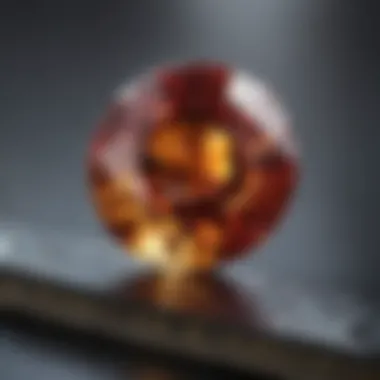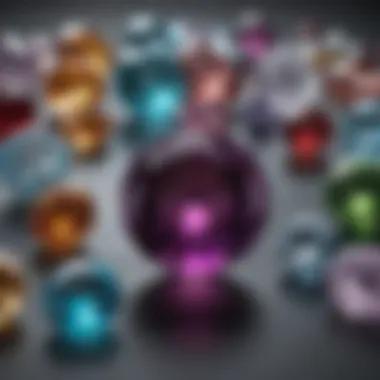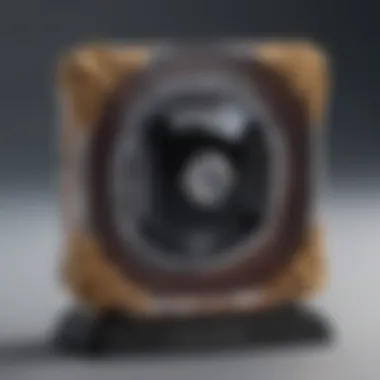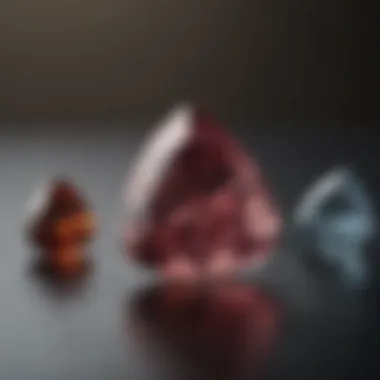Converting Millimeters to Carats in Gemstones


Intro
Understanding the measurement in gemology goes beyond mere dimensions. The conversion from millimeters to carats is key for anyone engaged with gemstones. Factors such as size, shape, and density of the gemstone significantly influence this conversion. As you explore this topic, you will gain insight into how these measurements impact purchase decisions and evaluations.
Gemstone Overview
Definition and Origins
Gemstones are naturally occurring minerals that have been cut and polished for decorative purposes. The journey of gemstones begins deep within the earth, where they form under high pressure and varying temperatures over thousands of years. The most famed gemstones include diamonds, sapphires, rubies, and emeralds. Each type of gemstone has unique properties that contribute to their desirability in the market.
Historical Significance
Throughout history, gemstones have played a crucial role in various cultures. They were often used in ceremonial functions, as talismans, and as symbols of wealth and power. The ancient Egyptians revered lapis lazuli while the Romans prized sapphires for their beauty and rarity. As civilizations evolved, the methods of mining and trading these treasures transformed, paving the way for the modern gemstone industry.
Gemstone Properties
Hardness and Durability
A gemstone's hardness is measured on the Mohs scale, quantifying its resistance to scratching. Diamonds, for instance, rank as the hardest mineral, while softer stones like talc are more susceptible to damage. This hardness affects not only the gemstone's durability but also its market value.
Color and Clarity
Color is a core characteristic that influences a gemstone's beauty. Each gem has a color range, often influenced by impurities or structural defects. Clarity, or the absence of inclusions and blemishes, is equally vital. A clear diamond may fetch a much higher price than one with visible inclusions. The combination of color and clarity often determines the overall quality and worth of a gemstone.
"Understanding the nuances of color and clarity helps collectors make informed decisions about purchases."
As you engage with gemstones, it's essential to consider how size interacts with weight. For example, a one-carat diamond may have varying dimensions based on its cut and shape. To navigate these intricacies effectively, being informed about conversions and the factors that influence them will vastly benefit any gemstone enthusiast.
Preface to Gemstone Measurements
The measurements of gemstones, specifically their size and weight, are essential for various reasons within the gemstone industry. Understanding the fundamentals of these measurements can significantly impact buying, selling, and appraisals. For enthusiasts, collectors, and jewelry designers, the knowledge of how size correlates to weight in gemstones guides informed decisions, thus ensuring the value of acquisitions.
The Importance of Size and Weight
Size and weight are not just numerical values; they hold crucial importance in the valuation and trade of gemstones. In the gemstone market, both are used to assess worth and desirability. Consumers often prefer larger stones, which sometimes leads to misconceptions about a gem's true value. Beyond aesthetic appeal, the size can influence the market price, making it essential for buyers and sellers alike to accurately understand these metrics.
- Weight vs. Size: Consumers might assume a larger stone naturally weighs more. However, density varies among gemstones. A small, dense stone can weigh more than a larger, lighter one.
- Market Trends: The demand for specific sizes can shift with trends. Being informed allows collectors to make strategic purchases.
Size and weight directly affect how a gemstone is perceived, providing context for its market value and desirability.
What Are Millimeters in Gemstone Terms?
Millimeters (mm) serve as a standard unit of measure within the gemstone community. Unlike carats, which signify weight, millimeters represent the physical dimensions of a gemstone, primarily its diameter in the case of round stones or its overall dimensions for fancy cuts. Dealers often rely on precise millimeter measurements to communicate the size of a gemstone accurately.
It is important to note how different cuts affect the perceived size. A shallow cut affects how light interacts with the stone, thus the visual size may appear different.
Understanding the Carat Weight System
Carat weight is a unit that measures the mass of gemstones. One carat is equivalent to 200 milligrams. This metric affects the valuation of stones, influencing prices heavily. For consumers, understanding carat weight is vital, especially when comparing different types of gemstones.
Moreover, carat weight impacts appearance. A one-carat diamond, for instance, may look smaller than a one-carat sapphire because of differences in density and cut. Carat measurements offer a guideline to assess quality, clarity, and size in one value, but buyers must be cautious of only relying on this metric when evaluating stones.
"Carat weight is crucial, yet it does not exclusively define a gemstone's quality or aesthetic appeal."
For those interested in gemstones, understanding these measurements opens up avenues for appreciation and valuation. Whether one is buying or selling, a solid grip on these concepts ensures a better grasp of market dynamics.


Defining Key Terms and Concepts
Understanding the critical terms and principles in gemstone measurement is fundamental for anyone dealing with stones, whether for personal interest or professional engagements. It lays the groundwork for recognizing how size and weight convey value and authenticity in gemstones. This section will clarify essential units and historical context, as well as dispel misconceptions related to gemstone measurements. This knowledge will enhance the reader's ability to make informed decisions during purchases, appraisals, or sales.
Millimeter as a Measurement Unit
Millimeters serve as a standard unit of measurement in the gemstone industry. In many cases, a gemstone's size is directly communicated in millimeters, particularly for stones that are cut and polished. Measuring diameter in millimeters allows buyers to visualize the stone's physical dimensions more accurately, which is especially important for items like rings or pendants that require specific fits.
Millimeters provide a precise gauge; however, individuals should note that the size does not always represent the weight. Though gemstones may have the same measurements in mm, their weights in carats can differ based on the gemstone type. Facilitating a basic understanding of millimeters is essential for both sellers and purchasers, as it directly impacts perceptions of worth and desirability.
Carat: A Historical Perspective
The term carat traces back to the carob seeds historically used as a standard for weighing gemstones. These seeds were favored because of their relatively uniform weight. The carat has since evolved into a formal metric measure, equivalent to 200 milligrams or 0.2 grams. One carat is often visually equated with a specific size, but the actual appearance depends significantly on the gemstone's density.
Historically, the adoption of the carat as a unit has streamlined transactions, but it also carries implications surrounding rarity and value. A higher carat weight typically signifies greater value, but it is essential to remember that quality attributes like clarity, color, and cut also substantiate a gemstone’s worth.
Common Misconceptions about Carats
Many misconceptions regarding carats may lead to confusion among buyers. One prevalent misunderstanding is the belief that a higher carat weight automatically results in higher value. While it is an important factor, it is not the sole one. Clarity and color are equally crucial.
Another misconception is that all gemstones have the same density. This assumption can lead to significant errors in understanding their weight when converting from millimeters to carats. For example, a one-carat diamond is smaller than a one-carat amethyst due to differences in density.
To avoid confusion, it is vital to engage with reputable gemological resources and professionals who can provide accurate insights regarding these measurements.
"Understanding the terms surrounding gemstone measurements will elevate your knowledge greatly and improve your confidence in making gemstone-related decisions."
By grasping the fundamental concepts of millimeters and carats, enthusiasts can navigate the intricate landscape of gemstone valuation with increased clarity.
Mathematical Relationship Between mm and Carats
The conversion between millimeters and carats is essential for anyone involved with gemstones. Understanding this relationship allows jewelry makers, gem collectors, and buyers to gauge value and quality accurately. It is not merely about numbers; this relationship helps in making informed decisions during purchases or appraisals. Without clear insight into the conversion metrics, buyers might unintentionally overpay or undervalue a gemstone.
This section will delve into two key aspects: direct conversion formulas and the variances based on the specific types of gemstones. Both elements are critical for a complete understanding of how size translates into weight, impacting market transactions and individual understanding of gemstones.
Direct Conversion Formulas
The direct conversion formulas serve as foundational tools for converting millimeters to carats. However, it is important to note that there are no universal formulas applicable to all gemstones due to the structural variances in their compositions.
The most common formula used is for round brilliant cut diamonds, where it can be approximated that:
- 1 carat is equal to approximately 6.5 mm in diameter.
This basic formula applies primarily to round-cut diamonds.
For other shapes or types of gemstones, adjustments may be necessary. While this formula can help in basic calculations, understanding the proportionality and individual characteristics of gemstones is essential.
A deeper understanding of direct conversion can be supported by using reference tables published by gemological institutions. These tables outline typical dimensions for gemstones and their corresponding carat weights which can facilitate more accurate conversions.
Variances Based on Gemstone Type
Not all gemstones share the same density or refractive index. Thus, variations exist in how millimeter sizes are translated into carats. Different types of gemstones have distinct physical properties, which influence their weight in relation to size. Here are some examples:
- Diamonds: As previously noted, diamonds generally follow the 6.5 mm = 1 carat guideline for round cuts.
- Sapphires and Rubies: These typically weigh heavier for the same size compared to diamonds, given their denser crystal structures.
- Emeralds: For emeralds, the standards vary even more. A 1 carat emerald could be closer to 7 mm in size because of lower density in their crystal lattice.
The type of gemstone significantly affects conversion, complicating the equation. Therefore, a clear understanding of each gemstone's characteristics is necessary when performing conversions to avoid misleading evaluations.
"Understanding the specific gemstone's properties is crucial to making accurate conversions from mm to carats."


In summary, direct conversion formulas provide a starting point, but gem type variances must be taken into account for accurate measurements. By grasping the mathematical relationship between these two metrics, enthusiasts and experts can navigate the complexities of the gemstone market more effectively.
Factors Influencing Gemstone Weight
Understanding the factors that influence gemstone weight is essential for anyone engaged in the gemstone industry. Weight, often measured in carats, significantly impacts the value and marketability of gemstones. Various intrinsic and extrinsic elements contribute to this measurement, proving the complexity beyond mere physical dimensions. Factors that can affect weight include the type of gemstone, its cut, clarity, and the overall design of the piece. A clearer comprehension of these elements is fundamental for collectors and sellers alike.
Variations Among Different Gemstones
Each gemstone has a unique density, which directly contributes to its weight. For instance, a cubic zirconia is heavier than a diamond when comparing equal sizes. The following points explain these variations further:
- Density Differences: Gemstones possess different densities, which is the mass per unit volume. Heavier gemstones will usually have a higher carat weight than lighter materials of the same size.
- Types of Gemstones: For example, emeralds and rubies typically weigh more than topaz or aquamarine when sizes are similar due to their density.
- Environmental Impact on Weight: Factors such as the origin of the gemstone can also play a role. Rare gemstones from specific locations might have varying inclusions, altering their overall density.
In summary, knowing these differences allows buyers to assess how a gemstone's size translates into weight more accurately.
Implications of Gemstone Cut on Weight
The cut of a gemstone does not just affect its appearance; it also impacts its weight significantly. The following outlines how the cut influences overall weight:
- Precision of Cut: A well-cut gemstone can retain more weight versus one that is poorly cut. Optimal cutting techniques aim to maximize brilliance while preserving carat weight.
- Depth and Table Size: The table is the flat surface of the gem that faces up, while the depth is the height from table to the culet, the bottom point. A steeper cut may result in a loss of weight compared to a flatter cut of the same diameter.
- Proportions: Gemstone weight is also affected by its proportions. For example, if a round brilliant cut appears larger and heavier due to symmetry, it might still weigh less than it looks if it is not proportionate.
Practical Guide to Converting mm to Carats
Understanding the conversion from millimeters to carats is essential for individuals involved in the gemstone field. Accurate conversion enables better evaluations and purchasing decisions. It promotes transparency between buyers and sellers. Each gemstone is unique, and dimensions directly influence its carat weight. Knowledge in this area can prevent misunderstandings during transactions.
This practical guide focuses on methods and tools to achieve accurate conversions. It emphasizes a systematic approach. Following steps and using specific tools will yield reliable results. Moreover, a clear process is beneficial for both novice and expert users.
Step-by-Step Conversion Process
To convert millimeters to carats effectively, start by determining the specific gemstone's type. Shape and material play significant role in weight calculations. Typically, round gemstones have a standard formula, while other shapes might require adjustments.
Here is a simple step-by-step process:
- Measure Diameter: Using a caliper, measure the gemstone's widest diameter in millimeters.
- Shape Identification: Identify the shape. Common shapes include round, oval, emerald, and pear. Each has a distinct volume-to-weight ratio.
- Use Conversion Formula: Apply the appropriate formula for the identified shape. For example, for a round gemstone, the conversion formula is:
- Calculate: Perform the calculation to find the carat weight.
- Double-check: Validate the measurement directly against gemstone standards.
This methodical approach helps ensure accuracy in conversions. It reduces common errors, which can lead to financial repercussions.
Using Tools for Accurate Measurement
Accurate conversion also relies on using the right tools. Quality measuring equipment enhances precision. Here are key tools worth considering:
- Digital Calipers: They provide precise measurements. Look for models that offer ease of use.
- Gemstone Scales: These are crucial for weighing gems accurately. Some scales can measure in both grams and carats.
- Conversion Charts: Maintain charts for quick references. These charts help confirm calculations.
Integrating these tools into your process improves efficiency. It leads to more credible results and boosts confidence in transactions.
"Accurate measurements are the backbone of gemstone evaluations. A minor miscalculation can dramatically affect value."
Using appropriate tools in conjunction with a structured conversion process will facilitate more informed decisions in the gemstone market.
Real-World Applications of Conversion Knowledge
Understanding the conversion from millimeters to carats is essential for anyone involved in the gemstone industry. The practical applications of this knowledge reach beyond academic interest; they significantly influence buying, selling, and appraising gemstones. This section will explore the implications of conversion knowledge in business transactions and valuation processes.
Impacts on Buying and Selling Gemstones
When purchasing gemstones, buyers are often misled by the allure of size, not knowing that larger millimeter measurements do not always correlate directly with higher carat weight. Knowledge of conversion can help consumers better assess value, ensuring they pay a reasonable price based on actual weight. Smaller, high-quality gemstones might have a greater value due to their rarity, regardless of size.


For sellers, accurate weight conversion can enhance marketing strategies. By understanding how to properly convert dimensions into carat weight, sellers can transparently communicate with potential buyers. This fosters trust and informs buyers about what they are acquiring. The more accurate the information shared, the better the chance of closing sales successfully.
Additionally, having a foundational grasp of this conversion allows both sides in the transaction to negotiate effectively. For example, if a seller offers a stone they claim is a certain carat weight, the buyer with knowledge of the conversion can challenge or confirm this assertion based on the gemstone’s physical dimensions.
Application in Appraisal Processes
In appraisal, converting measurements accurately is crucial. Gemologists and appraisers must evaluate gemstones using standardized criteria. Carat weight remains a core component of appraisal formulas. Applying the correct mm to carat conversion ensures that the valuation reflects the true worth of the gemstone.
Furthermore, appraisals affect insurance values and resale potential. An inaccurate appraisal based on incorrect measurements can lead to substantial financial repercussions. If an insured gemstone is improperly valued due to miscalculations, the owner may find themselves underinsured during a claim. This situation highlights the necessity for appraisers to possess an intimate understanding of size to weight conversions.
When a gemstone comes under evaluation, factors such as shape and cut must be considered alongside the conversion metrics. It’s not just about measuring length and width, but comprehending how these dimensions influence the overall appearance and desirability of the stone.
As a practical guide, appraisers can utilize conversion charts and calculators to support their evaluations. Such tools streamline the appraisal process, promoting accuracy and efficiency.
“An accurate understanding of mm to carat conversion is the backbone of responsible gemstone trading.”
This knowledge directly supports fair trade practices, benefitting both buyers and sellers by nurturing a transparent market environment.
Ultimately, the real-world implications of understanding gemstone measurements extend across all levels of the industry. From individual transactions to professional appraisals, the ability to convert and comprehend these dimensions is critical for making informed decisions.
Case Studies: Conversions in Practice
Understanding the conversion from millimeters to carats requires practical examples. This section focuses on real-world case studies, illustrating how these conversions apply across various gemstone types. Case studies provide tangible insights into the complexities involved, demonstrating not just mathematical calculations but also the nuances that affect gemstone weight. The exploration of these examples enhances the reader's understanding of the subject and allows for informed decisions in the gemstone market.
Examples from Various Gemstone Types
Different gemstones exhibit unique densities and characteristics, influencing how their sizes translate into weight. For instance, consider the following examples:
- Diamond: A one-carat diamond typically has a diameter of about 6.5 mm when cut round brilliant. The consistent density of diamonds allows straightforward conversions from size to weight.
- Emerald: Although an emerald of similar size may also measure around 6.5 mm, the gem has a lower density approximately 2.7 compared to the diamond's 3.5. Thus, it might weigh less than a carat when sized the same. This variance necessitates special attention when evaluating the carat based on size measurements.
- Ruby: A ruby stone with a size of 7 mm might weigh around 1.2 carats, showing how each type of gemstone has specific weight ratios based on its unique properties.
These examples illustrate the need for careful consideration when determining a gemstone's worth and characteristics based on its measurements.
Analysis of Common Trends in the Market
Trends in gemstone sales reflect the complexities of size and weight conversions. One common trend is the preference for larger stones, regardless of the carat weight. Customers often gravitate toward stones that visually appear larger rather than those that are heavier by weight.
- Size vs. Value: It is not uncommon for two gemstones of equal visual size to differ significantly in value. Dense stones, like diamonds, can command higher prices at lower carat weights compared to lighter stones like amethysts.
- Market Shifts: Recent shifts have shown a growing interest in unique shapes and cuts. Non-traditional cuts might make the stone appear larger while weighing less, changing consumer perceptions of value.
"The weight of a gemstone should not be the sole factor in assessing its value; its size and visual impact also play crucial roles."
- Collector Preferences: There are collectors who prefer stones that weigh more despite their smaller sizes, driven by rarity and quality attributes. This creates a layered understanding of market trends.
Practical case studies demonstrate that understanding conversions is essential for stakeholders in the gemstone market. Whether buying, selling, or appraising gemstones, knowing how mm translates to carats—and vice versa—can significantly impact investment decisions.
Ending: Importance of Accurate Measurements
In the world of gemstones, accuracy in measurement plays a pivotal role. Gemstone measurements directly influence the valuation of stones, affecting decisions in buying, selling, and appraising. Errors in measuring can lead to misunderstandings about a gem’s quality and worth. The relationship between millimeters and carats is not merely academic; it has real-world implications. When purchasing a gemstone, understanding its size in millimeters and its corresponding weight in carats provides a clearer picture of what to expect.
Precisely measuring a gemstone ensures that enthusiasts and professionals make informed decisions rooted in accuracy. This understanding fosters trust between buyers and sellers, crucial in a market filled with nuances. More than just a numeric conversion, precision helps maintain industry standards and transparency.
Summarizing Key Insights
- Key Relationships: The relationship between millimeters and carats is essential. The measurement in mm gives insight into the physical dimensions, while carat weight informs about its density and value.
- Factors of Influence: Various factors can influence these measurements. These include the type of gemstone, cut, and clarity. Each of these plays a crucial role in determining the true value and visual appeal of the gemstone.
- Practical Knowledge: Mastering this conversion offers a practical advantage. Knowing how to convert mm to carats empowers gemstone collectors and enthusiasts, enabling them to make more educated choices in their purchases.
Accurate measurements not only reflect professionalism but also enhance the credibility of the gemstone trade.
Future Considerations in Gemstone Measurement
In the future, the evolution of gemstone measurement may involve more advanced technology. Developments such as 3D scanning and digital measuring tools could enhance measurement accuracy and ease. Automation in gem appraisal might also emerge, providing faster and more reliable assessments.
As gemstone enthusiasts, staying informed on these advancements is essential. Understanding future trends can help individuals adapt to changes in the market and improve their acquisition strategies. Additionally, as sustainable sourcing becomes more relevant, precise measurements could support better transparency in ethical practices within the industry.
With ongoing global discussions around gemstone trade practices, it’s vital that knowledge of accurate measurement continues to grow, adapting alongside consumer demands and industry standards.



